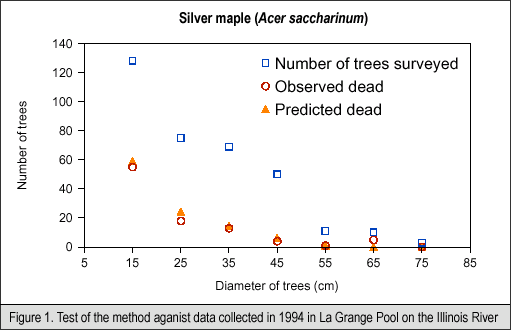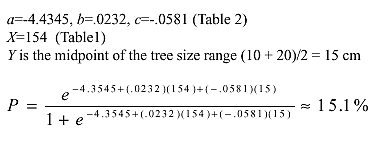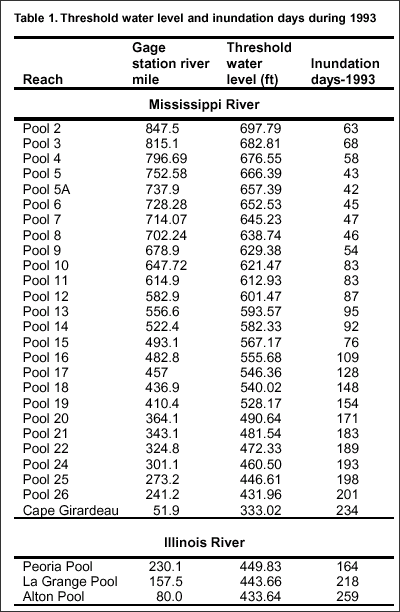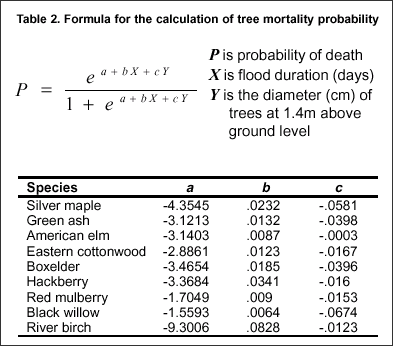|
PSR 97-01 February 1997 Estimating Inundation-Induced Tree Mortality Using River Water Level Databy Yao Yin |
|
Flooding profoundly affects many forms of vegetation that live in the Upper Mississippi River ecosystem. One of the hardest hit classes is trees. By cutting off oxygen to the roots, floodwater creates an anaerobic environment that is toxic to trees. Woody species in the Upper Mississippi River system, with the exception of bald cypress, can not survive lengthy inundation. The flood of 1993 provided a vivid demonstration of this fact. Inundation lasting much of the 1993 growing season led to the death of almost 40% of the adult trees and up to 80% of the juvenile trees located in Pool 26 near St. Louis, Missouri (Yin et al. 1994). Management of the floodplain forests must be adapted to flood regimes of the river. An important part of such management is the ability to accurately and rapidly assess flood damage. Unfortunately, assessment of flood damage to forests has often been hampered by (1) the high cost of field surveys and (2) the wait for visible signs of damage to appear. Based on these considerations, the Environmental Management Technical Center initiated a project in 1996 to search for an alternative assessment method. The alternative method under development can potentially be used
to calculate the probability of tree mortality based on water level
data of the river. In this method, the probability of tree mortality
is defined as a function of inundation duration and size of the
tree. The method includes a formula to determine the threshold water
level of inundation using historical river water level data and
formulas to calculate the probability of tree mortality based on
inundation duration and tree size. Inundation duration is defined
as the total number of days when river water level is at or above
the threshold water level between January 1 and December 31. Parameters
in the tree mortality probability formulas were estimated by applying
linear logistic regression on data collected in 1994 and 1995 at
seven reaches along the Upper Mississippi River. The formulas were
tested against data collected in 1994 and 1995 at one reach on the
Illinois River (Figure 1). Using this method, we have calculated the threshold water levels for selected reaches of the Upper Mississippi and Illinois Rivers and their corresponding inundation duration in 1993 (Table 1). We have also provided the formulas for the calculation of mortality probabilities of nine woody species (Table 2). Using these formulas and inundation duration data, the percentage mortality of trees killed during 1993 can be retrospectively estimated by size class of the trees. For example, in Pool 19 the mortality rate of silver maple trees between 10 and 20 cm in diameter during 1993 may be estimated as follows:
Reference: Yin, Y., J. C. Nelson, G. V. Swenson, H. A. Langrehr, and T. A. Blackburn. 1994. Tree mortality in the Upper Mississippi River and floodplain following an extreme flood in 1993. pp 41-60, In: Long Term Resource Monitoring Program 1993 flood observations. National Biological Service, Environmental Management Technical Center, Onalaska, Wisconsin. LTRMP 94-S011. 190pp. |
|
|
|
This report is a product of the Long Term Resource Monitoring Program for the Upper Mississippi River System. For further information, contact Yao Yin
Project Status Reports (PSRs) are preliminary documents whose purpose is to provide information on scientific activities. Because PSRs are only subject to internal peer review, they may not be cited. Use of trade names does not imply U.S. Government endorsement of commercial products. All Project Status Reports are accessible through the Upper Midwest Environmental Sciences Center’s website at http://umesc.usgs.gov/reports_publications/psrs/umesc_psr.html |
Page Last Modified: April 17, 2018





